By Steve Shupert
There is a wide variety of rotary saw blades being marketed for fire service use. Many of these blades are quite expensive, and I’ve yet to have a “loaner” blade offered. So, not only might you spend money on a blade that doesn’t meet your needs, you may have to make do for a while.
The purpose of this article is to provide users with information to make a more informed decision when sorting through the specifications. Aside from misspending money, you may void your saw warranty and create a safety problem for your crews.
A historical perspective is always helpful: What have you had to cut on past calls? And, how did the saw and blade combination perform? Are there any new risks moving into the community?
BLADE RPM VS. SPINDLE SPEED RPM VS. PERIPHERAL SFPM
When shopping for a blade, compare the spindle speed (revolutions per minute, or rpm) of your saw to the rpm rating of the blade. Matching the blade specifications to the saw capabilities is important to get the best, safest performance from both.
The peripheral speed of a blade is measured at the outer edge of the blade and will be different for a 12- and 14-inch blade, typically between 16,000 and 18,000 surface feet/minute (sfpm), respectively. What you want is the spindle speed, or the actual rpm of the saw arbor, and this will be different from engine rpm (the rate the spark plug fires, typically a maximum of 9,000 rpm), so read your manual and be sure to correctly match the “right” rpm to your saw and blade. These speeds create a gyroscopic effect on the saw so it resists changes in orientation.
Three major saw manufacturers’ spindle speeds range from 5,100 to 5,400 rpm at no load, full speed. When using a 12-inch blade, the cutting depth will be 3 inches. A 14-inch blade has a cutting depth of 5 inches. Adjust the blade guard to control cutting depth. For comparison, an electric 7¼-inch circular saw has a maximum rpm of 1,500. The rpm is not a good indicator of cutting speed—that will be dictated by blade condition/application, material size/type, and density. Cutting speed/feed rate is also greatly determined by how well your saw is operating. With any blade, cut at 90° to the work piece, if possible. Do not force the saw so much that it slows more than 10% of full unloaded speed. If the blade stops rotating, let off the trigger and remove the blade from the cut to prevent damage to the drive belt. Listening to the saw/blade is key to efficient cutting.
Whenever possible, do not stand directly in line with a blade when cutting. Do not twist the blades while cutting; they can only be loaded in a radial manner (pushing straight down). Use caution if cutting in the upper quadrant of any blade. This may cause an unwanted reaction force and make the saw climb up and away from the operator, possibly causing an injury.
SAW/BLADE ARBOR SIZE
Your saw will most certainly have an arbor (where the saw blade mounts) of 20 mm, 7⁄8 inch, or 1 inch. Bushings are available to adapt 20 mm to 17⁄8 inch and 7⁄8 inch to 1 inch. These bushings can be metal or plastic, worth having in your toolbox. To secure the blade, torque the arbor bolt 22 to 25 foot-pounds.
ABRASIVE COMPOSITE BLADES
Abrasive composite blades have maximum rpm of 5,200 for 12-inch blades and 6,000 for 14-inch blades. These are offered for specific applications and will be labeled as such: wood, plastic, ceramic, stainless steel, steel, aluminum, iron, and so on. These cutting discs are made of highly abrasive materials (for our purposes) such as aluminum oxide and silicon carbide. They are the most affordable rotary saw blade; however, they wear out fast.
These blades lose diameter as they grind, cutting shallower and shallower as they go. This process exposes fresh grit to maintain uniform grinding. Take care not to side load any blades but especially these, as they will crack and shatter. Inspect blades for any cracks or damage. Any damage is reason enough to throw them away. When first starting up a saw with a fiber blade, hold it away from everyone and run it at full speed to see if the centrifugal forces tear it apart. If it stays together, put it to work.
Do not allow these blades to be exposed to gasoline and oils, which can degrade the resin bonding of the fibers and grit. Silicon carbide has a harder grit compared with aluminum oxide, but silicon carbide is less durable because it is brittle and has a narrower shape that wears down at an increased rate.
CARBIDE BLADES
Twelve-inch carbide blades have a maximum rpm of 6,000, while 14-inch blades have a maximum rpm of 5,500. It is usually not recommended by gas rotary saw manufacturers to use a carbide blade (check the manual), but carbide blades are used by many fire departments. The Occupational Safety and Health Administration (OSHA) requires a fully guarded blade on any cutoff blade larger than 4 inches. Fire departments are not exempt from OSHA regulations. The risk OSHA is trying to control is a carbide segment breaking off from the core and flying at high speed, injuring someone. However, if you use this type of blade on your rotary saw, document that you have trained your staff in the risks involved with using this blade plus the dos and don’ts (see sidebar). Sometimes the carbide segments can be resharpened by the factory or have fresh segments reattached. For emergency work, it is better to just buy a new blade that has not been stressed. Look for worn-down, chipped, broken, and missing teeth or chipped carbide tips.
Carbide blades do not have a set; the alternating bending of teeth to the right and left creates a kerf (space) wider than the blade to reduce the blade getting jammed. This is compensated for on carbide blades because the carbide teeth are wider than the saw core. These blades cut, making chips, not dust.
Thin sheet metal (bendable by hand) can be easily cut with a carbide blade. It will also cut polycarbonate plastic quite well. It cuts thin high strength steel alloy (HSSA) with ease. This blade works well for shingles and roof sheathing. It can handle nails easily enough, but do not try to cut heavy metal or concrete with this blade. You will see “carbide” blades for cutting steel and concrete. These are a different type of carbide called “cermet,” and cermet needs to run at a speed too slow for gas-powered rotary saws to cut these materials.
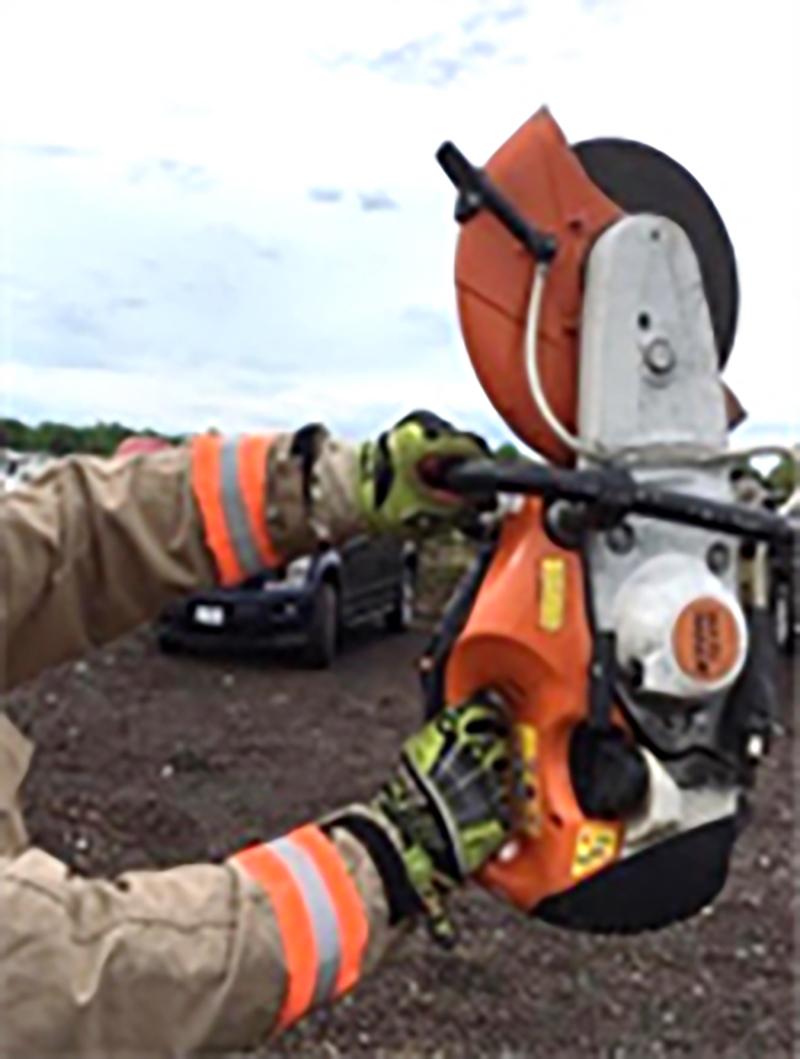
1 With a fiber wheel, point in a safe direction and run the saw up to full speed to test blade integrity/security before cutting. (Photos by author unless otherwise noted.)
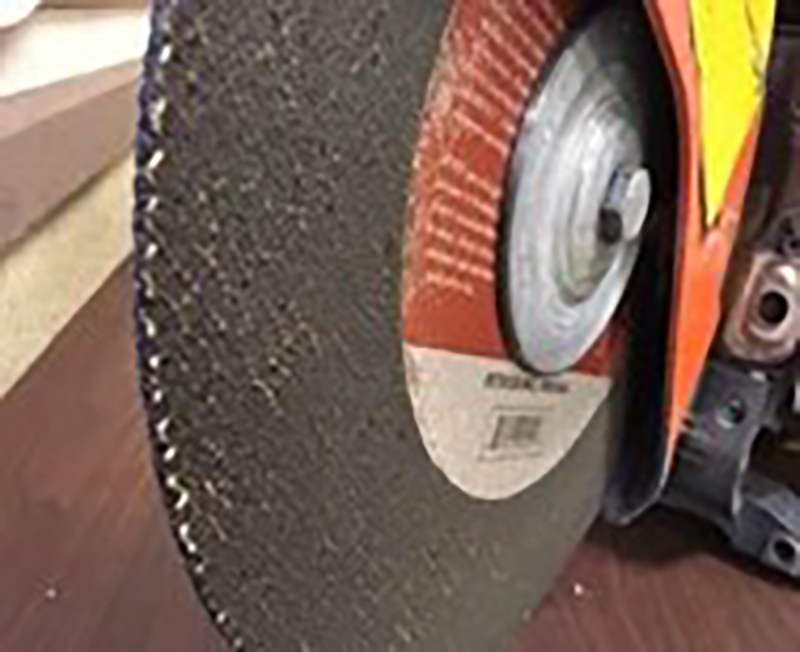
2 Do not side load or expose a fiber wheel to gas or oil.
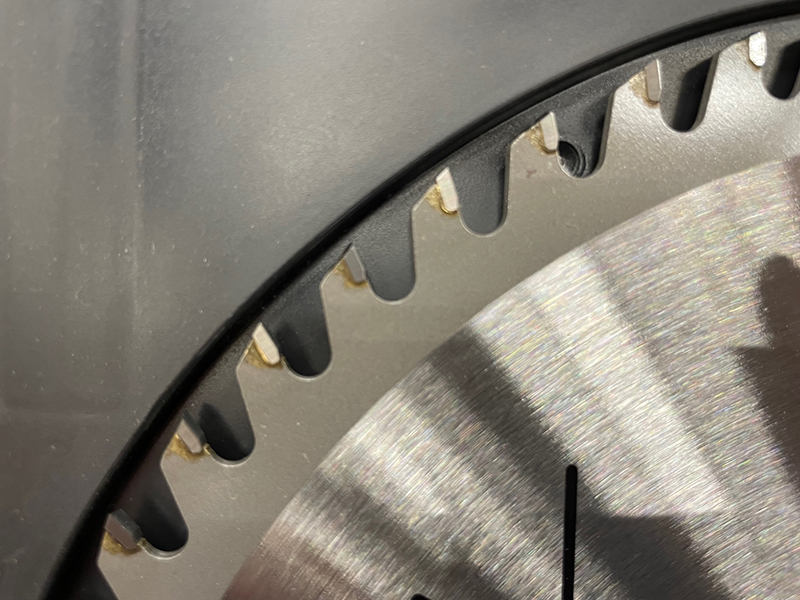
3 Inspect a carbide blade for any missing tips.
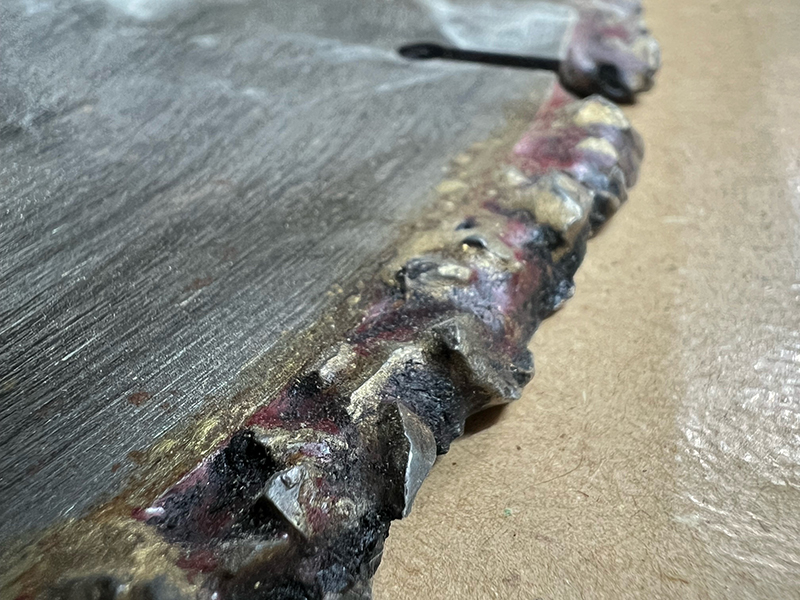
4 A carbide chunk, also marketed as a stump grinder.
WARTHOG BLADE© (12-INCH CARBIDE TIPPED)
This blade is constructed with carbide tips and designed for fire departments cutting through floors, walls, and roofs. A thicker blade design provides greater strength and durability. Always follow the manufacturer’s operating guidelines. Fewer teeth than a typical carbide blade results in a more aggressive cut. The large gullets between the teeth are necessary to provide space for the material being removed so it doesn’t jam up the blade. This is a heavy/wide saw blade—be prepared for the large pieces of debris it throws. This blade does not like being taken on and off, as it tends to put excessive wear on the bolt.
CHUNK CARBIDE BLADES
These blades have a maximum rpm of 5,350 for both 12- and 14-inch blades. Just as the name implies, chunks of carbide are attached to a steel core wheel rather than uniform tips. The core is thicker than other saw blades, and it cuts a wider kerf than a typical carbide blade. The chunks can cut the same materials as the carbide-tipped blades. They are typically more expensive than a traditional carbide-toothed blade. They can be used wet or dry.
CERMET BLADES
Cermet blades have rpm ratings of 1,800 to 3,500. Often called the new carbide, cermet has been around since the 1930s and is also marketed as Carbide II. It is a blade tipped with a composite material of carbide, ceramic tungsten, titanium, and other elements, depending on the application. We use it to cut carbon steel, nonferrous metals, stainless steel, wood, and composite materials. It is a very efficient, durable blade that will outperform carbide or diamond.
Cermet blades cost up to 30% more but can last 50% longer. Some of the larger blades can be sent back to the manufacturer for resharpening, but the smaller blades are disposable. If you have missing and/or chipped teeth, replace the blade. These blades are rated to run slow—1,800 to 3,500 rpm—when compared with a two-cycle rotary saw, which can turn at more than 5,300 rpm.
DIAMOND BLADES (6400 MAX RPM 12-INCH: 5400 MAX RPM, 14-INCH)
Diamond blades have 6,400 maximum rpm for 12-inch blades and 5,400 for 14-inch. One of the most common questions related to this type of blade is, “Are diamond cutting wheels made of diamond?” The short answer is no. Diamond blades are very durable, abrasive wheels coated with diamond crystals on their cutting edge. The diamond crystals used are synthetic diamonds, not natural diamonds. Synthetic diamond crystals are some of the hardest materials available. These blades grind, creating dust. There are three types of shapes for the diamond cutting wheels:
- Segmented rim: Features narrow, U-shaped slots that improve air flow and dissipate heat when cutting. Suitable for dry cutting. Use for concrete, reinforced concrete, masonry, natural stone, and cement. Good for rescue.
- Continuous rim: Features solid J-slots that are suitable for wet application as the J-slots around the edge help to dissipate heat and increase cutting speeds. This type of wheel is ideal for very fine separating cuts. Use for porcelain, tiles, granite, marble, and ceramics—not for rescue work.
- Turbo rim: Features a continuous rim with an edge that is serrated for easy, fast, and smooth cutting. Suitable for both wet and dry cutting. Use for concrete, reinforced concrete, masonry, natural stone, and cement. It has the best heat resistance and is best for rescue.
Gas-Powered (2-Cycle) Rotary Saw Equipped with a Carbide-Tooth Blade SOPThe intent of this procedure is to provide guidance on safe and proper operation, including maintenance and inspection of a rotary saw carbide blade. All staff are to read this and comply.
|
These blades are composed of a steel core or wheel with alloy segments on the tips containing bits of industrial diamond. Diamonds are embedded in the alloy, and as the blade grinds through the work piece, the alloy scrapes away, exposing fresh diamonds. When cutting some materials such as asphalt or steel, you may “glaze” your diamond blade, giving it a shiny appearance. Diamond segments should appear slightly rough and visible as small bumps in the alloy. If your cutting slows down, inspect the segments for glazing. To sharpen, or dress, a diamond blade, simply cut into some clean concrete, as this will reexpose fresh diamonds and increase cutting speed. Continued cutting with a glazed blade will cause the diamond segment/alloys to overheat and come loose from the steel core. As your diamond blade wears out, it will cut slower and slower and eventually won’t cut at all because the cutting segments have completely worn down.
The loose segments can fly off at extreme speed and cause injury to the operator or others. The alloy, or powdered metal, holding the diamonds is what gives the blade its application rating. Harder powdered metal will be rated for a softer application such as asphalt or green concrete. Softer powdered metal will be rated for harder material like older, more cured concrete.
You can cut steel with a diamond blade, especially concrete encased steel such as rebar. The blade will not become glazed because as the diamonds grind through the steel, it immediately passes against the concrete, which instantly resharpens. The problem with cutting steel with a diamond blade is the alloy matrix in which the diamonds are suspended. Nickel, almost always present in the matrix, becomes sticky when hot, and the steel adheres to it, clogging the diamonds and preventing grinding. Any missing, damaged, or cracked segments are cause for taking the blade out of service and replacing it. Diamond blades cannot be put on backward. You can determine the proper direction by looking for the comet trails, which is a tapering path left as the diamond grit wears away. Some blades will have a directional arrow on the core.
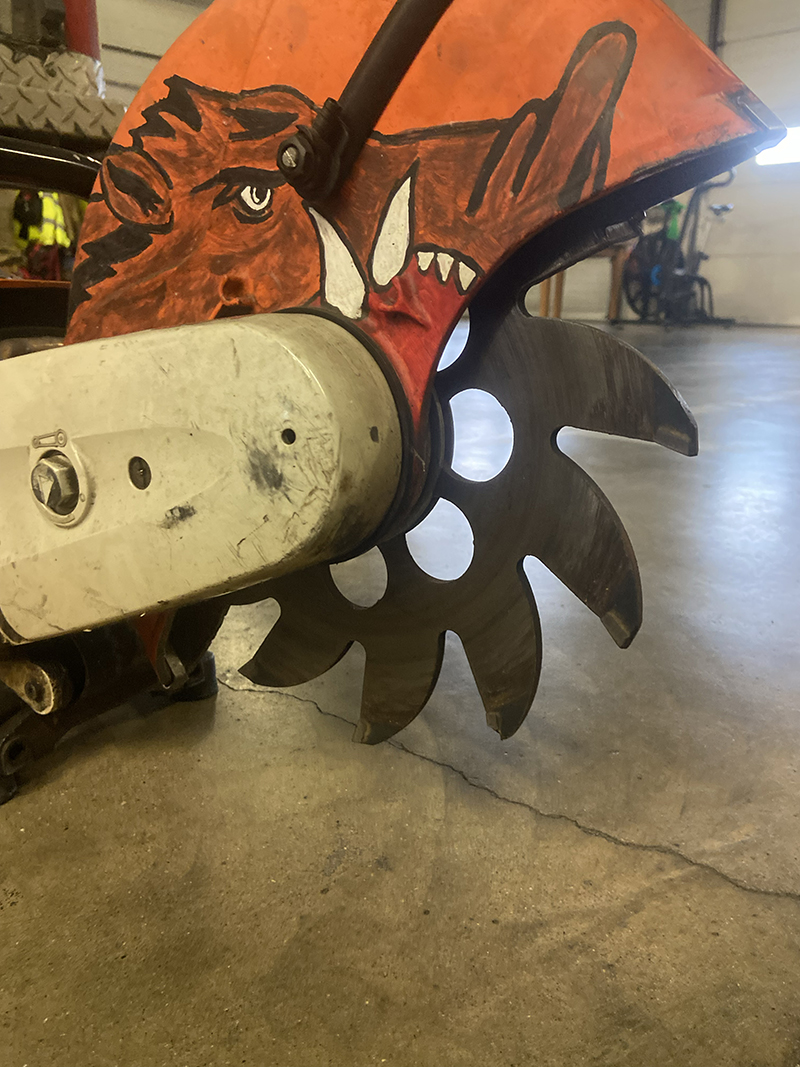
5 The Warthog is an aggressive, durable blade designed for fire departments. [Photo courtesy of the Miami Valley (OH) Fire District.]

6 When inspecting a diamond saw blade, rotate it and look for straightness, no missing/cracked segments, a thin coating of oil, and that it is properly secured.
Diamond blades can be rated for wet cutting (spraying water on the blade) or dry cutting (where the use of water is not required but can be used). The diamond blades used in the fire service are usually dry cut blades so, if you are without water, you can still cut. Using water will not damage a dry cut diamond blade, greatly reduces the amount of harmful dust created by cutting, creates a slurry for faster concrete cutting, and extends the life of the blade.
A common mistake when applying water to a diamond blade operation is to use too much water. The slurry (mixture of water and concrete dust) should form a peak when pinched. This abrasive mixture will speed your cutting. We often apply far too much water, overflushing the needed grit. Considerations for applying water include the following:
- Water placement: Ensure that adequate water flow is evenly distributed on each side of the blade during cutting.
- Water volume: Water volume should be roughly 4 gallons per minute and not a high-pressure flow to the blade. The proper water volume will increase as the depth of grind increases.
- Let the blade do the cutting: Excessive pressure on the blade while in the cut may cause the diamonds to glaze over, also creating stress cracks in the core, causing the blade to become out of round. When dry cutting, the blade should be allowed to cool off by allowing it to spin freely out of the cut every minute or so. Avoid dry cutting plastic pipe with this blade, as the heat will melt the plastic, sticking to the blade and almost certainly causing a kickback.
When water cannot be used, take measures to ensure that the operator does not inhale the dust/silica created by sawing. Concrete dust can cause silicosis, a serious lung disease. OSHA has regulations regarding silica dust and requires a (minimum) P100 NIOSH-approved respirator where silica dust is present.
MULTIPURPOSE DIAMOND BLADES
Great advances have been made in diamond saw blades. Several of the “multipurpose” diamond blades offer good performance over a wide range of materials. These blades are manufactured using a process called vacuum brazing. This process bonds the diamond segment to the steel core without using flux, giving it a stronger connection. This brazing process gives the blade better resistance to heat. But, as with most multipurpose things, it loses some performance by trying to meet all material applications. These blades make for good RIT blades where you may need to cut through multiple types of materials.
CLEANING AND MAINTENANCE
Often these rotary blades get built up with pitch, rust, tar, or gum, creating friction and slowing down the cut. Get a shallow pan large enough to immerse the blade. Soak it in a degreaser solution for 10 to 15 minutes. For other built up “gunk,” use a citrus-based cleaner. After soaking, use steel wool, a wire brush to remove, and polish. Apply a film of oil to prevent corrosion. This works for tarred-up chainsaw chains too.
Just because you may have not done any tough saw work in a while doesn’t mean your blade has not sustained damage. Regularly inspect your blade for any damage, cracks, missing segments, or bent cores. If you are feeling increased resistance to the saw/blade making progress, the blade may be dull, need to be dressed (exposing fresh grit), or cleaned. Keep fresh fuel in your well-tuned saw. Train your crews on what they can and can’t cut.
As an operational suggestion, have two rotary saws. Equip one with a carbide-tooth blade for vertical ventilation, floor, and wall cuts in ordinary construction. Outfit the second saw with a multipurpose diamond blade to cut commercial doors, heavy metal, car hoods (engine compartment fires), brick, and block. And, keep a supply of abrasive blades handy as a backup.
STEVE SHUPERT is a lieutenant (ret.) from Miami Valley Fire District, Montgomery County, Ohio. He is rescue team manager and training officer for Ohio Task Force #1 US&R. He is a veteran of 11 federal deployments, including WTC and Hurricane Katrina, a member of the DHS/FEMA Rescue Sub Group, a certified rescue specialist, a structural collapse specialist instructor, and a heavy equipment rigging specialist instructor. Shupert is director of training for Crash Course Village, a 501C3 nonprofit organization.

